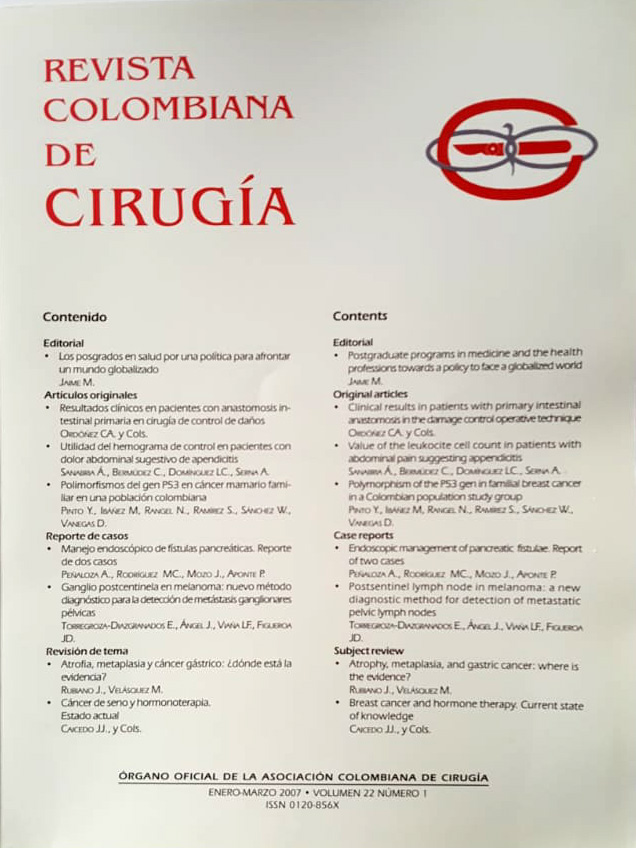Ganglio postcentinela en melanoma: nuevo método diagnóstico para la detección de metástasis ganglionares pélvicas
Palabras clave:
melanoma, biopsia del nódulo linfático centinela, metástasis linfáticaResumen
Los ganglios inguinales son el primer sitio de afectación metastásica del melanoma primario de las extremidades inferiores. Cuando se comprueba metástasis ganglionares inguinales no es claro si solamente se debe realizar linfadenectomía inguinal superficial (linfadenectomía ganglionar limitada) o si por el contrario, se debe efectuar linfadenectomía pélvica (cadena ganglionar ilíaca externa y obturador), además de la linfadenectomía inguinal superficial (linfadenectomía ganglionar extendida o combinada). Se propone al ganglio postcentinela como nuevo método diagnóstico capaz de predecir el compromiso ganglionar pélvico y así reducir el número de vaciamientos pélvicos innecesarios.
Descargas
Referencias bibliográficas
2. Jost LM. ESMO Minimum clinical recommendations for diagnosis, treatment and follow-up of cutaneous malignant melanoma. Ann Oncol 2003; 14: 1012-1013.
3. Pardo C, Murillo R, Piñeros M, et al. Casos nuevos de cáncer en el Instituto Nacional de Cancerología, Colombia, 2002. Rev Colom Cancerol 2003; 7: 4-19.
4. Gershenwald JE, Berman RS, Porter G, et al. Regional nodal basin control is not compromised by previous sentinel lymph node biopsy in patients with melanoma. Ann Surg Oncol 2000; 7: 226-231.
5. Karakousis CP. Therapeutic node dissections in malignant melanoma. Semin Surg Oncol 1998; 14: 291-301.
6. James JH. Lymphoedema following ilio-inguinal lymph node dissection. Scand J Plast Reconstr Surg 1982; 16: 167-171.
7. Urist MM, Maddox WA, Kennedy JE, et al. Patient risk factors and surgical morbidity after regional lymphadenectomy in 204 melanoma patients. Cancer 1983; 51: 2152-2156.
8. Montesinos MR, Falco JE, Sinagra D, et al. Valor del vaciamiento inguinal en melanoma cutaneo. Rev Argent Cir 1999; 76: 80-88.
9. Cohen MH, Schour L, Felix EL, et al. Staging laparotomy in the treatment of metastatic melanoma of the lower extremities. Ann Surg 1975; 182: 710-714.
10. McCarthy JG, Haagensen CD, Herter FP. The role of groin dissection in the management of melanoma of the lower extremity. Ann Surg 1974; 179: 156-159.
11. Singletary SE, Shallenberger R, Guinee VF. Surgical management of groin nodal metastases from primary melanoma of the lower extremity. Surg Gynecol Obstet 1992; 174: 195-200.
12. Coit DG, Brennan MF. Extent of lymph node dissection in melanoma of the trunk or lower extremity. Arch Surg 1989; 124: 162-166.
13. Dasmahapatra KS, Karakousis CP. Therapeutic groin dissection in malignant melanoma. Surg Gynecol Obstet 1983; 156: 21-24.
14. Karakousis CP, Emrich LJ, Rao U. Groin dissection in malignant melanoma. Am J Surg 1986; 152: 491-495.
15. Karakousis CP, Driscoll DL. Positive deep nodes in the groin and survival in malignant melanoma. Am J Surg 1996; 171: 421-422.
16. Jonk A, Kroon BB, Rumke P, et al. Results of radical dissection of the groin in patients with stage II melanoma and histologically proved metastases of the iliac or obturator lymph nodes, or both. Surg Gynecol Obstet 1988; 167: 28-32.
17. Fortner JG, Booher RJ, Pack GT. Results of groin dissection for malignant melanoma in 220 patients. Surgery 1964; 55: 485-494, 485-494.
18. Kissin MW, Simpson DA, Easton D, et al. Prognostic factors related to survival and groin recurrence following therapeutic lymph node dissection for lower limb malignant melanoma. Br J Surg 1987; 74: 1023-1026.
19. Sterne GD, Murray DS, Grimley RP. Ilioinguinal block dissection for malignant melanoma. Br J Surg 1995; 82: 1057-1059.
20. Gupta TK. Results of treatment of 269 patients with primary cutaneous melanoma: a five-year prospective study. Ann Surg 1977; 186: 201-209.
21. Strobbe LJ, Jonk A, Hart AA, et al. Positive iliac and obturator nodes in melanoma: survival and prognostic factors. Ann Surg Oncol 1999; 6: 255-262.
22. Finck SJ, Giuliano AE, Mann BD, et al. Results of ilioinguinal dissection for stage II melanoma. Ann Surg 1982; 196: 180-186.
23. Illig L, Aigner KR, Biess B, et al. Diagnostic excision of the Rosenmuller's node. Screening for occult metastases before elective regional lymph node dissection in patients with lower limb melanoma? Cancer 1988; 61: 1200-1206.
24. Strobbe LJ, Jonk A, Hart AA, et al. The value of Cloquet's node in predicting melanoma nodal metastases in the pelvic lymph node basin. Ann Surg Oncol 2001; 8: 209-214.
25. Hughes TM, A'Hern RP, Thomas JM. Prognosis and surgical management of patients with palpable inguinal lymph node metastases from melanoma. Br J Surg 2000; 87: 892-901.
26. Johnson TM, Fader DJ, Chang AE, et al. Computed tomography in staging of patients with melanoma metastatic to the regional nodes. Ann Surg Oncol 1997; 4: 396-402.
27. Kuvshinoff BW, Kurtz C, Coit DG. Computed tomography in evaluation of patients with stage III melanoma. Ann Surg Oncol 1997; 4: 252-258.
28. Acland KM, O'Doherty MJ, Russell-Jones R. The value of positron emission tomography scanning in the detection of subclinical metastatic melanoma. J Am Acad Dermatol 2000; 42: 606-611.
29. Prichard RS, Hill AD, Skehan SJ, et al. Positron emission tomography for staging and management of malignant melanoma. Br J Surg 2002; 89: 389-396.
30. Kaplan J, González A, Huertas E, et al. Vaciamientos ganglionares superselectivos en el melanoma cutáneo. Oncol Clin 2006; 3: 135-137.
Descargas
Publicado
Cómo citar
Número
Sección
Licencia

Esta obra está bajo una licencia internacional Creative Commons Atribución-NoComercial-SinDerivadas 4.0.
Todos los textos incluidos en la Revista Colombiana de Cirugía están protegidos por derechos de autor. Las opiniones expresadas en los artículos firmados son las de los autores y no coinciden necesariamente con las de los directores o los editores de la Revista Colombiana de Cirugía. Las sugerencias diagnósticas o terapéuticas como elección de productos, dosificación y métodos de empleo corresponden a la experiencia y al criterio de los autores.


















.jpg)


